5 Best National Parks to See Bison in the USA
Once roaming the Great Plains by the millions, then almost hunted to extinction, the American bison (Bison bison) is now the national mammal of the USA.
Together with the bald eagle, America’s national bird, the two animals represent the country’s amazing natural beauty, both on land and in the sky.
Bison are the largest land mammal in America, an essential part of American history, a true symbol of the American West and the nation as a whole. They’re also a testimony to the power and potential of nature conservation, epitomized by the national parks.
This post featuring the best national parks to see bison contains affiliate links. You can read more about our Terms of Use / Disclosure here.
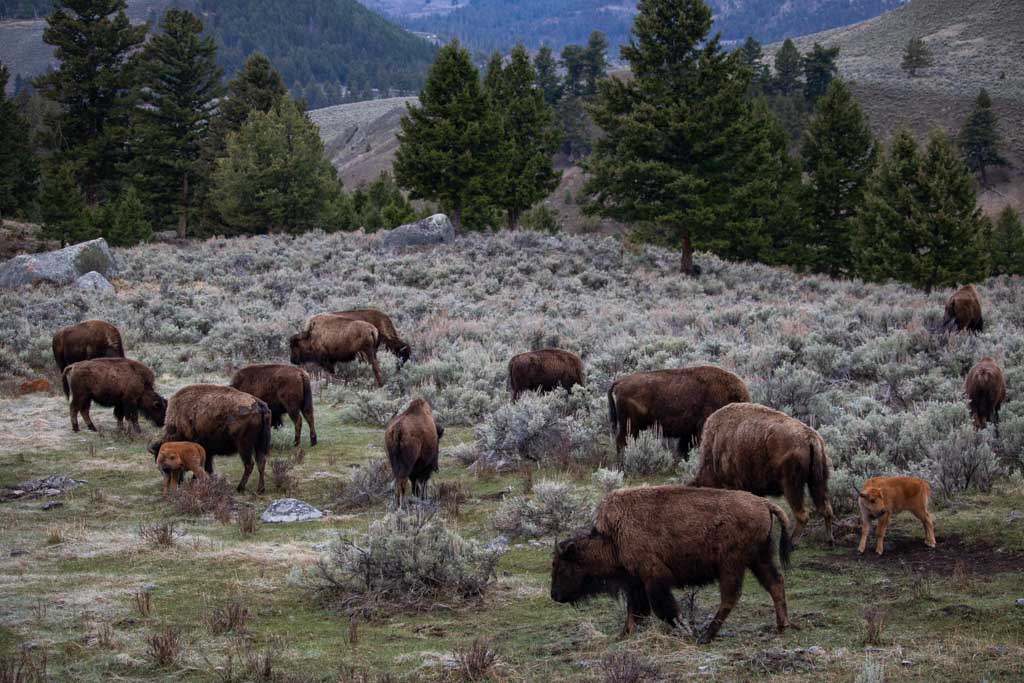
From Abundance to Near-Extinction to Protection: A Brief History of Bison in the USA
For hundreds of thousands of years, American bison, often also (wrongly) called buffalo, roamed the Great Plains in truly massive numbers—estimates go as high as 30 to 60 million. Then, Euro-American settlers arrived.
By the end of the 19th century, after just a few decades of mass slaughter, fewer than 1,000 wild bison remained.
Now, after dedicated conservation efforts, including in national parks like Yellowstone, Grand Teton, Badlands, Wind Cave and Theodore Roosevelt, there are once again many thousands of wild bison in America.
However, the plains bison conservation status is still “near threatened.” They’re not out of the woods yet, so to speak.
Nowadays, the American Plains are home to 17 federally managed bison herds. About 20,000 plains bison are managed as wildlife.
Only 5,000 of them, however, are actually disease-free and unfenced. Most of those live in Yellowstone National Park, which is the only place in the U.S. where bison have lived continuously since prehistoric times.
And this brings us to the topic of this blog post: the best national parks to see bison in America.
Best U.S. National Parks to See Bison
1. Yellowstone National Park, Wyoming, Idaho and Montana
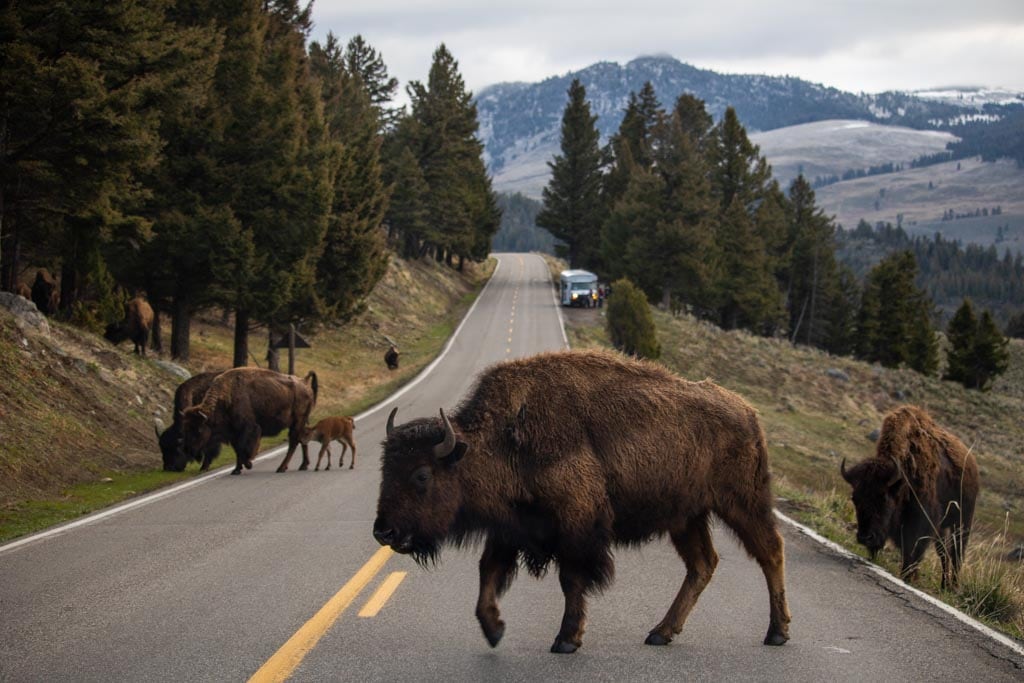
If you’re wondering where to see bison in America, Yellowstone is the most common and logical answer.
Often referred to as “North America’s Serengeti” because of its huge annual animal migrations, Greater Yellowstone is home to healthy populations of American megafauna.
This includes wolves, black bears and grizzly bears, elk and bison, making Yellowstone one of the best national parks for wildlife viewing.
In fact, Yellowstone National Park is the only place in the U.S. that’s always had a wild bison population. Everywhere else, the animals went extinct and were later introduced again.
So, Yellowstone is without question the first place you should go if you want to see American bison in their natural habitat.
Additionally, the Yellowstone National Park bison herds are also unique for being the nation’s largest bison population on federal land and because it doesn’t consist of bison that are hybridized through interbreeding with cattle. These are pure American bison, if you will.
They’re actually so wild that they still show behavior that their ancient ancestors also would have, including migration and exploration, as well as gathering during the mating season.
It’s that very behavior that, also greatly thanks to the conservation movement, has helped the species to survive beyond the 19th-century hunting craze and thrive at Yellowstone once again.
The Yellowstone bison population is estimated at about 4,500 animals, made up of two main breeding herds, one large herd in the north of the park and one smaller one in the center.
The best places to see bison in Yellowstone are the Lamar and Hayden Valleys, where they’re present year-round.
In summer, you have a good chance of seeing them in the grasslands, while in winter, they hang out around the park’s hydrothermal areas and the Madison River.
More About Yellowstone National Park
- Park Website
- Travel Guide
- Topographic Map
- Top Places to Visit in Yellowstone National Park
- Best Things to Do at Mammoth Hot Springs (Yellowstone)
- Best Spring Hikes in Yellowstone National Park
- Accommodation
2. Grand Teton National Park, Wyoming
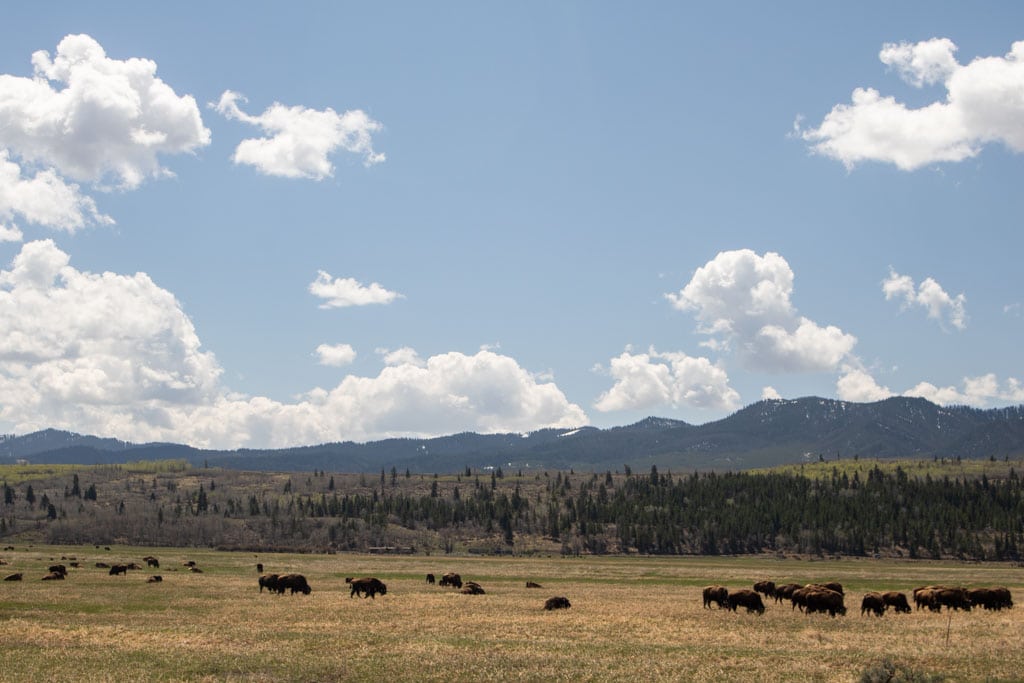
Located just south of Yellowstone in Wyoming and part of the Greater Yellowstone ecosystem, Grand Teton National Park also has a relatively large bison herd. The park’s home to nearly 1,000 bison.
Besides bison, Grand Teton also houses most other large animals that you can see in Yellowstone as well, including moose, elk, wolves, black bears and grizzly bears. Both parks are often combined in one extended trip, with Jackson Hole as a popular base.
The best places to see bison in Grand Teton National Park are along Mormon Row, which is particularly beautiful at sunrise, as well as the Antelope Flats Road and the grasslands along the Snake River.
More About Grand Teton National Park
- Park Website
- Travel Guide
- Topographic Map
- Best Grand Teton Hikes
- Top Things To Do in Grand Teton National Park
- Best Views of the Tetons
- Accommodation
3. Theodore Roosevelt National Park, North Dakota
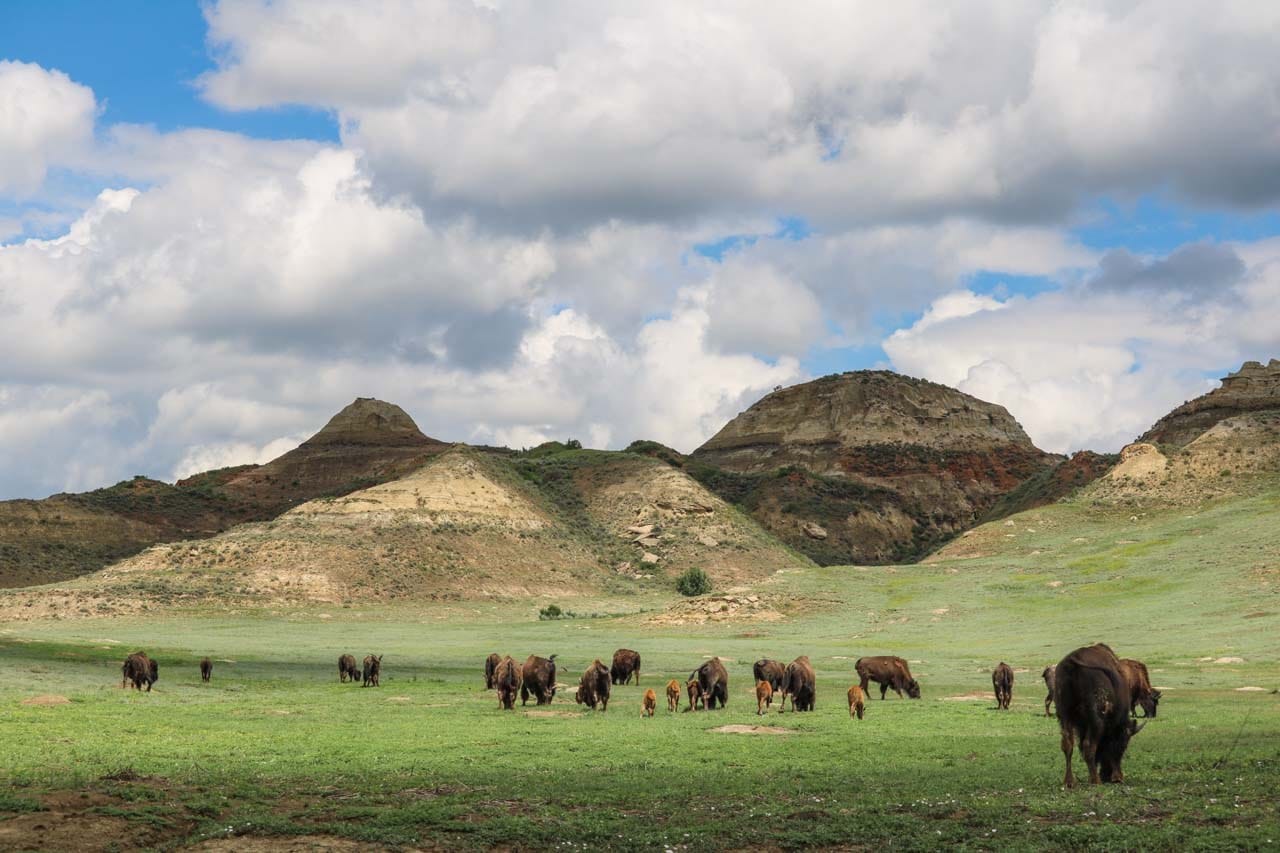
While historically, they certainly would’ve roamed the badlands and valleys of what is now Theodore Roosevelt National Park in North Dakota, there were no longer any bison present when the park was established in 1947.
The first Theodore Roosevelt National Park bison were introduced almost a decade later in 1956. This founding population consisted of 5 male and 24 female bison, transferred to the park’s South Unit from Nebraska’s Fort Niobrara National Wildlife Refuge.
As a historic inhabitant of North Dakota, bison are well adapted to the state’s extremely varied climate, from freezing cold winters to scorching hot summers. This is why that founding herd absolutely thrived and produced lots of offspring.
In fact, because the bison’s only natural predators—wolves and grizzly bears—were never reintroduced since they went extinct from North Dakota in the 1880s, the Theodore Roosevelt bison population quickly reached the park’s grazing resources.
Now, the bison herd in Theodore Roosevelt National Park’s South and North Units is actively managed. The target herd sizes are respectively 200-500 and 100-300 animals.
You don’t need much luck to spot bison in this wonderful and, honestly, underrated national park. Simply going for a drive on the South Unit’s Scenic Loop Drive almost guarantees bison sightings.
More About Theodore Roosevelt National Park
- Park Website
- Travel Guide
- Topographic Map
- Top Things To Do in Theodore Roosevelt National Park
- Accommodation
Highly Recommended Book:
American Buffalo: In Search of a Lost Icon – Steven Rinella
4. Badlands National Park, South Dakota
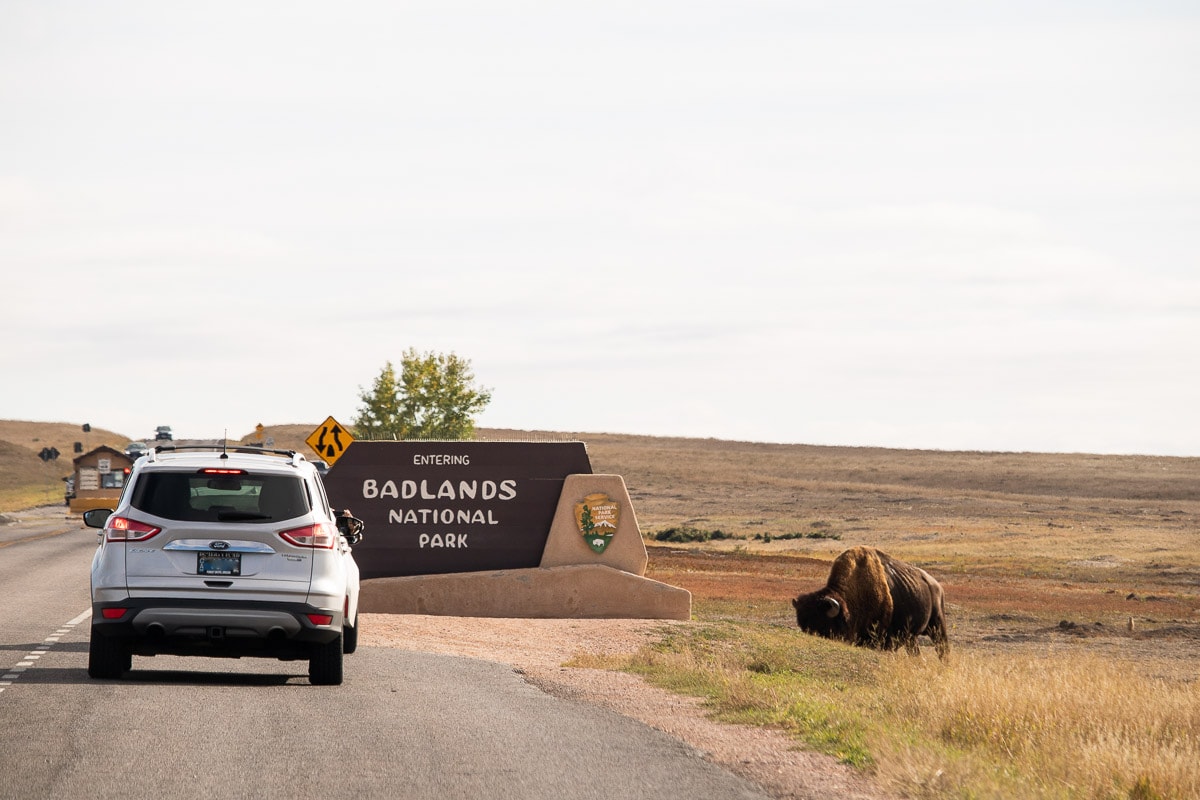
Another national park in the Dakotas where you can see bison is Badlands National Park. Located a short drive from Rapid City, South Dakota, this beautiful park has also played an important role of the bison conservation story in America.
The Badlands bison conservation history began in the 1960s with the introduction of 50 animals.
Another 20 bison were added in the 1980s. That initial herd fared pretty well in its new environment and now the park’s population stands at about 1,200.
This officially puts the Badlands National Park bison population above the threshold of a “conservation herd”, meaning that the current population should be able to naturally take care of its own reproduction and expansion.
Moreover, recently a handful of bison were released into a newly expanded range within Badlands National Park. This expanded the range of American bison in Badlands, which is another important step in the growth of America’s national mammal’s overall population.
Read more about wildlife in Badlands National Park here!
More About Badlands National Park
- Park Website
- Travel Guide
- Topographic Map
- Best Badlands Hikes
- Top Things to Do in Badlands National Park
- Where to See Wildlife in Badlands National Park
- Best Badlands Views
- Accommodation
5. Wind Cave National Park, South Dakota
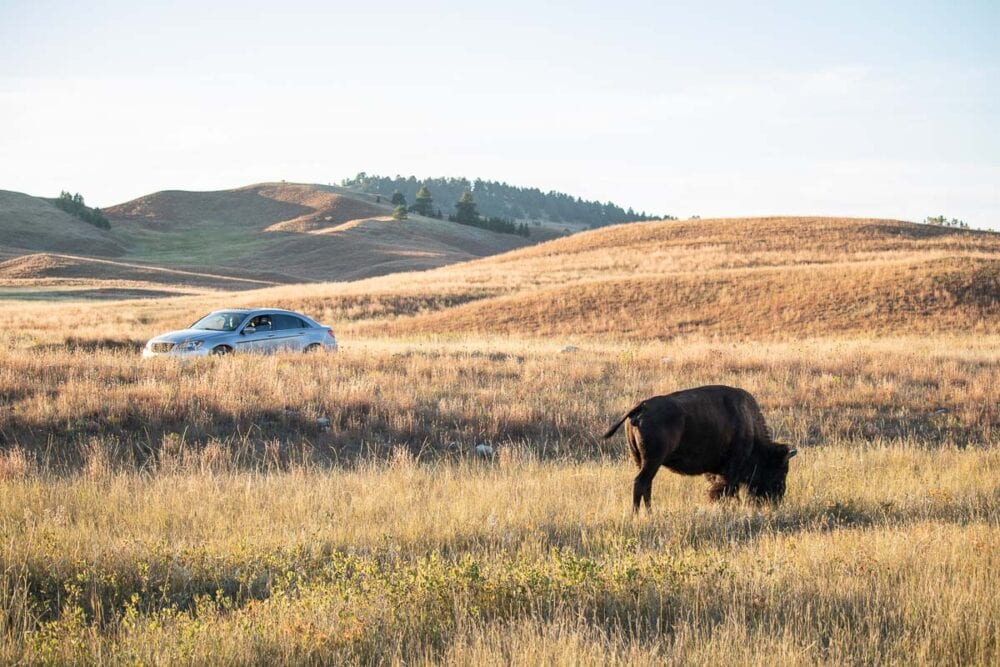
Just west of Badlands National Park lies Wind Cave National Park. This park, too, is one of the best national parks to see bison in America.
Actually, the Wind Cave bison herd of 250 to 500 animals is one of only two genetically pure American bison herds in a national park. The other one is, of course, in Yellowstone National Park. While this is obviously a great thing, it’s also cause for great concern.
It’s of the utmost importance to preserve this genetic purity, which can be used to reintroduce pure American bison elsewhere on the continent.
The great challenge lies in keeping the pure Wind Cave National Park bison herd separated from the herd in neighboring Custer State Park, which does include hybridized animals.
The Wind Cave National Park landscapes are an absolutely ideal environment for bison and other Great Plains wildlife. Made up of expansive prairie and the iconic Black Hills of South Dakota, the park sits in the heart of a sacred region in the culture of the Native Americans of the Great Plains.
When visiting this park, your chances of seeing bison are nearly 100%. You might not see them right away—where’s the fun in that?—but patience will pay off.
More About Wind Cave National Park
- Park Website
- Travel Guide
- Topographic Map
- Top Things To Do in Wind Cave National Park
- Where to See Wildlife in Wind Cave National Park
- Accommodation
Other Great Places to See Bison in America
In addition to those five national parks that are home to bison, there are also several other Great Plains parks and preserves where you can see bison.
- Tallgrass Prairie National Preserve, Kansas
- Chickasaw National Recreation Area, Oklahoma
- Wichita Mountains Wildlife Refuge, Oklahoma
- Custer State Park, South Dakota
- National Bison Range, Montana
- Antelope Island State Park, Utah
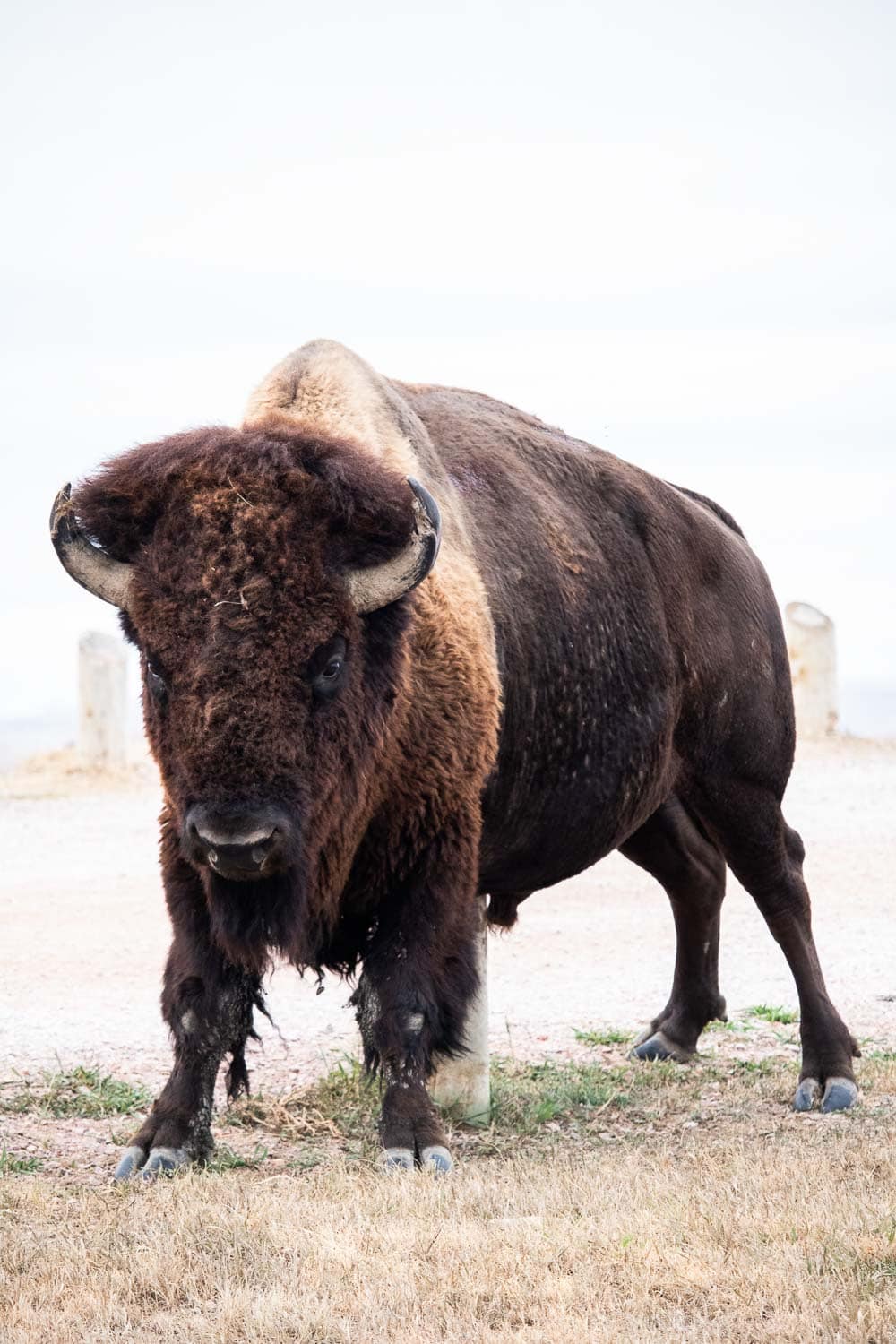
How to Stay Safe in Bison Country
Although grizzly bears, black bears, mountain lions and even rattlesnakes might strike most fear into the hearts of some hikers, they’re not nearly as dangerous as bison are.
In Yellowstone National Park, for instance, more people get injured by bison than any other animal, including the often-feared grizzlies.
These huge herbivores might seem gentle, calm and indifferent, but they’re notoriously unpredictable and protective.
Bison are also surprisingly agile and fast, and can run at a speed of up to 35 mph (which is basically as fast as a horse). Moreover, they can also jump over pretty high fences.
It is, therefore, very important to know how to behave in national parks that are home to bison. When you visit these parks, make sure to inform yourself about what to do when you encounter a bison, how to prevent attacks and what to do if a bison charges.
I’ve compiled all that useful—essential even—information in this blog post about bison safety. I recommend reading it thoroughly if you have plans to go bison viewing in the national parks above.





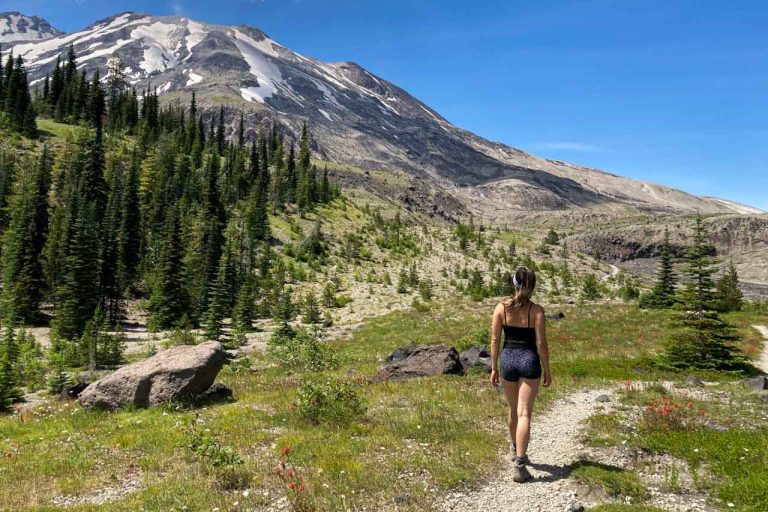

We saw a herd of approximately 16-18 bison on the North Rim of the Grand Canyon 8n August 2021.
Hi Kelly! Yes, there are bison in Grand Canyon National Park too, but I didn’t include them in this list because they were introduced in the early-1900s and aren’t historically native to the area. Still must have been quite the sight, though!
Bison were purposely exterminated by the US Army and US Government encouraging their slaughter to deprive the Nomadic Plains Indians of their primary food source.
That’s absolutely right. It’s thanks to the national parks, and especially Yellowstone, however, that the species survived.
Antelope Island State Park in Utah also has a large herd.
Thanks for that information, Diederik! Great tip!